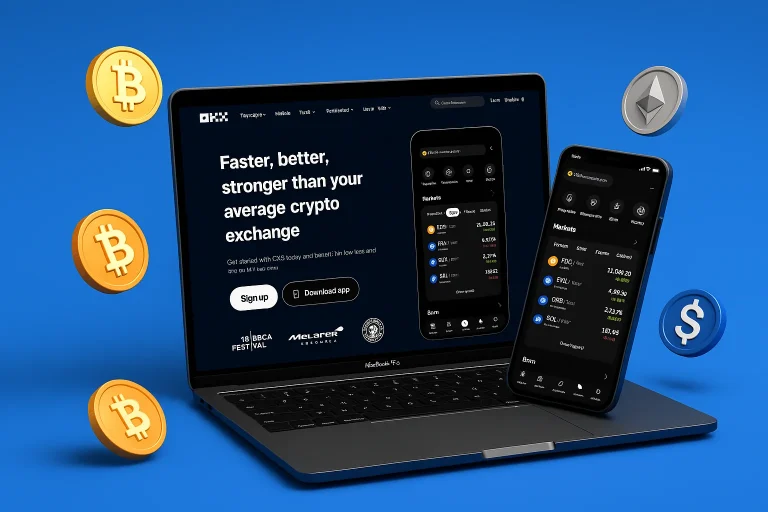Polkadot and Cardano are two of the most prominent names in the cryptocurrency industry today. Both offer something different, and that’s exactly what makes the choice confusing.
Polkadot connects blockchains, while Cardano focuses on long-term stability. Each attracts a different kind of user, especially those interested in staking or building in Web3.
This article compares Polkadot vs Cardano from the ground up, covering staking, structure, energy use, adoption, and the real differences that matter when choosing a platform.
Table of contents
- Polkadot vs Cardano: How It Works
- Polkadot vs Cardano: Architecture & Design
- Polkadot vs Cardano: Scalability
- Staking Cardano vs Polkadot
- Polkadot vs Cardano: Smart Contracts & Developer Experience
- Polkadot vs Cardano: Security & Ecosystem
- Cardano vs Polkadot: Adoption & Energy Efficiency
- DOT vs ADA: Price Prediction
- Polkadot vs Cardano: Pros and Cons
- FAQ
- Final Thoughts
Polkadot vs Cardano: At a Glance |
|
|---|---|
| Polkadot | Blockchain Type: Multi-chain (relay + parachains); Consensus mechanism: NPoS + GRANDPA; Smart Contracts: Rust, Solidity, WASM; Scalability: Sharding with parachains; Governance: On-chain (Council & Committee); Transactions per Second: Up to 1,000,000 TPS (projected); Energy Efficiency: Moderate (efficient but not PoS-only); Focus: Cross-chain dApps, scalability; Security: On-chain + off-chain measures; Use Cases: Cross-chain dApps, DeFi, and scalability solutions; Programming Language Support: Multi-language (via Substrate); Network Architecture: Relay chain, parachains, bridges; Compliance & Regulation: Not regulation-focused; Cross-Chain Interoperability: Core functionality using bridges and external networks; Treasury System: On-chain treasury (Polkadot Treasury); |
| Cardano | Blockchain Type: Layered single chain CSL + CCL; Consensus mechanism: PoS – Ouroboros algorithm; Smart Contracts: Plutus, Marlowe (Haskell); Scalability: Hydra (Layer 2 ) + slot leaders; Governance: Off-chain (IOHK & Cardano Foundation); Transactions per Second: Around 1,000 TPS with Hydra (projected); Energy Efficiency: High (pure PoS system); Focus: Regulated DeFi apps; Security: On-chain + off-chain measures; Use Cases: Smart contracts, DeFi, identity services; Programming Language Support: Haskell-based ecosystem; Network Architecture: CSL (settlement), CCL (computation); Compliance & Regulation: Designed with regulatory frameworks in mind; Cross-Chain Interoperability: Limited, but possible via KMZ sidechains; Treasury System: On-chain treasury funded by fees; |
Polkadot vs Cardano: How It Works
Polkadot (DOT)
Polkadot is more than a blockchain; it’s a decentralized network that connects multiple blockchains into one interoperable system. Its vision is to create a secure environment where independent chains collaborate and exchange data seamlessly.
At the heart of Polkadot lies the Relay Chain, which manages communication, security, and consensus across the entire network.
Key components include:
- Parachains: Independent blockchains tailored for specific use cases, running parallel for high-speed processing.
- Parathreads: Lighter, temporary chains ideal for projects that don’t require constant relay chain access.
- Validators: Network participants who validate transactions and maintain network security, earning rewards via the Polkadot treasury.
Developers can easily build custom blockchains using Substrate, while Kusama, Polkadot’s canary network, provides a real-world testing ground for new features. Projects like Moonbeam and emerging DeFi applications showcase Polkadot’s flexibility.
With its focus on secure cross-chain communication, network security, and low fees, Polkadot positions itself as a foundation for the future of crypto interoperability.
Cardano (ADA)
Cardano takes an academic, peer-reviewed approach to blockchain development, emphasizing security, sustainability, and scalability. Founded by Charles Hoskinson, one of Ethereum’s co-creators, Cardano combines scientific research with real-world application.
Its system operates on two distinct layers:
- Cardano Settlement Layer (CSL): This layer handles transactions and staking through a pure proof-of-stake model, reducing energy consumption.
- Cardano Computation Layer (CCL): This layer manages smart contracts and decentralized applications (dApps) using Plutus, offering developers flexibility.
This layered architecture enhances security and supports regulatory compliance, enabling scalable, efficient transactions. Cardano also integrates advanced solutions, such as the KMZ sidechain protocol for interoperability and Hydra, a scalability framework that aims to process millions of transactions per second.
Backed by robust research and strong development partnerships, Cardano has established itself as a leading contender in the evolution of decentralized networks.
Polkadot vs Cardano: Architecture & Design
Polkadot is built with a modular system. At the center is the relay chain, which keeps the network connected. Around it, projects like Kusama Polkadot help test updates before they reach the main chain. This setup allows Polkadot projects to grow independently while staying linked through cross-chain interoperability and secure bridges.
The Cardano blockchain uses a layered structure. The network is split into two parts: one for sending transactions and the other for running apps. It was designed with a regulatory compliance framework and keeps energy usage low. In the Cardano vs Polkadot debate, their design shows how they aim to solve different problems in crypto.
Polkadot vs Cardano Differences |
|
|---|---|
| Polkadot | Ecosystem Testing: Kusama canary network; Compliance: On-chain governance; Upgrades: Modular & project-tested; Security: Validators, parachains, and hardware modules; Scalability: Substrate, bridges; Market Context: Rapid growth, strong competition. |
| Cardano | Ecosystem Testing: Academic peer process; Compliance: Regulatory framework; Upgrades: Peer-reviewed releases; Security: Ouroboros and layered security; Scalability: Hydra, optional RSK; Market Context: Institutional adoption, steady growth. |
Polkadot vs Cardano: Scalability
Polkadot
Polkadot’s scaling approach relies on parallel parachains. This structure reduces congestion and keeps the Polkadot network flexible and fast.
The architecture supports scale-specific protocols and allows decentralized systems to grow without central bottlenecks.
Specifications |
|
|---|---|
| Scaling Method | Parallel parachains |
| Architecture | Modular, multi-network ready |
| Ecosystem Fit | Suit decentralized systems and enterprise use |
| Flexibility | Integrates with external chains and future upgrades |
Cardano
Cardano uses Hydra, a layer 2 upgrade that helps scale without compromising security. It’s designed to handle increasing load as more crypto projects join.
By separating logic through layers, Cardano supports other projects and builds toward long-term growth in the blockchain platform space.
Specifications |
|
|---|---|
| Scaling Method | Hydra Layer 2 with multi-head channels |
| Architecture | Dual-layer structure (CSL + CCL) |
| Use Case | Supports the gradual expansion of financial and social dApps |
| Efficiency | Designed to reduce latency while keeping energy low |
Staking Cardano vs Polkadot
Cardano
Cardano uses the Ouroboros consensus mechanism as part of its academic foundation. Stakers earn ADA without locking funds, which improves usability across crypto markets.
It reflects the project’s vision of Cardano as a secure, regulatory-aware blockchain and a long-term player in investors’ crypto portfolios.
Additionally, be sure to check the best Cardano wallets for a more seamless experience.
Specifications |
|
|---|---|
| Staking Method | Delegated PoS with Ouroboros consensus |
| Roles | Delegators and Stake Pool Operators |
| Rewards | Earned based on pool activity |
| Flexibility | No lock-up, fully liquid staking system |
Polkadot
Polkadot uses Nominated Proof of Stake, a key part of Polkadot’s architecture. It aligns with the project’s core goal of decentralization and secure governance.
Staking rewards help maintain the upgraded network, while users can support Polkadot projects or earn passively by nominating trusted validators.
Specifications |
|
|---|---|
| Staking Method | Nominated Proof of Stake (NPoS) |
| Roles | Validators and Nominators |
| Rewards | Earned from inflation and network transaction fees |
| Flexibility | Unbonding period before rewards can be withdrawn |
Polkadot vs Cardano: Smart Contracts & Developer Experience
Polkadot
Polkadot aims to offer flexibility through its overlay network protocol, supporting various languages like Rust and Solidity. This makes it easier for developers to build across other networks using Substrate, Polkadot’s core toolkit.
The ecosystem avoids common pitfalls in the crypto bubble, encouraging open development across crypto projects, and supports new platforms like the Rootstock smart contract platform via integrations.
Specifications |
|
|---|---|
| Language Support | Rust, Solidity, WASM (via Substrate) |
| Toolkit | Substrate framework |
| Dev Focus | Multi-chain dApps, secure design |
| Fees & Gas | Users pay transaction fees in DOT |
Cardano
Cardano focuses on academic rigor and safety in smart contract design. Its Cardano Computation Layer runs smart contracts written in Plutus, a secure, Haskell-based language.
This system enables users to build DeFi tools with better audibility, energy efficiency, and regulatory alignment, all essential in today’s crypto space.
Specifications |
|
|---|---|
| Language Support | Plutus (based on Haskell) |
| Dev Framework | Based on functional programming & formal methods |
| Network Design | Layered (via Cardano Computation layer) |
| Compliance Tools | Designed with consensus algorithms & regulation in mind |
| Compatibility | Less flexible but secure and predictable |
Polkadot vs Cardano: Security & Ecosystem
Polkadot
Polkadot’s security relies on shared validators and a modular design. The system includes hardware security modules and supports forkless upgrades, making it a key player in the Polkadot comparison debate.
Although its growing ecosystem faces tough Polkadot competition, it continues to expand through decentralized exchanges and parachain projects within the Bitcoin ecosystem.
Specifications |
|
|---|---|
| Validator Security | Shared security model across parachains |
| Upgrade Model | Forkless upgrades via governance |
| Modules | Uses hardware security modules |
| Ecosystem Growth | Active Polkadot projects & integrations with other networks |
| Risk Factors | Active Polkadot debate, rising market cap, and pressure from newer chains |
Cardano
Cardano puts security first through peer-reviewed code and the Hydra scalability solution, which increases safety as more users join. Its layered structure also makes vulnerabilities easier to isolate.
With growing exposure in the Ethereum team members’ circle and mainstream adoption, more users are buying Cardano as a secure long-term asset. It’s designed to enable users to stay compliant.
Specifications |
|
|---|---|
| Security Approach | Formal methods and staking model |
| Hydra Integration | Supports the Hydra scalability solution |
| Ecosystem Support | Input Output, and the Ethereum team members’ collaborations |
| Growth Indicators | High adoption; users buy Cardano for long-term use |
| Accessibility | Built for enabling users and secure crypto portfolio building |
Polkadot vs Cardano: Governance
Polkadot
Polkadot uses full on-chain governance. A Council, a Technical Committee, and token holders manage upgrades. This model gives power directly to the community.
It’s an open system that drives change fast but invites constant Polkadot debate. Still, it fits with Polkadot’s architecture and long-term vision.
Specifications |
|
|---|---|
| Governance Type | On-chain (Council+ referenda) |
| Community Role | Strong community, and users vote directly |
| Upgrade Process | Automatically applied if approved |
| Strength | Open, fast-moving |
| Weakness | Risk of governance overload |
Cardano
Cardano uses off-chain governance for now. Decisions come from IOHK, the Cardano Foundation, and EMURGO. A future upgrade (Voltaire) will bring full on-chain voting. It’s slower, but it’s designed for long-term trust and regulatory alignment.
Specifications |
|
|---|---|
| Governance Type | Off-chain, with planned on-chain (Voltaire) |
| Community Role | Moderate, not fully direct yet |
| Upgrade Process | Through research and formal approval |
| Strength | Stable, peer-reviewed |
| Extra | Reflects the cautious crypto project’s style that Cardano promotes |
Cardano vs Polkadot: Adoption & Energy Efficiency
Cardano
Cardano’s adoption is more focused. Its strong push into regulated zones, like Ethiopia, and use in identity and education make it different.
Its Ouroboros consensus mechanism is one of the most energy-efficient in the blockchain space. With features like Hydra and peer-reviewed upgrades, Cardano moves slowly but with purpose.
Specifications |
|
|---|---|
| Adoption Drivers | Gov partnerships, DeFi apps like SundaeSwap |
| Real-World Use | ID, finance, and Cardano blockchain in the public sector |
| Energy Model | Pure PoS with low usage |
| Efficiency Compared | One of the most eco-friendly options |
| Extra | Appeals to those seeking long-term stability |
Polkadot
Polkadot powers top DeFi apps like Moonbeam and Acala. Its flexible setup attracts many crypto projects that value cross-chain tools and easy integration. Adoption moves fast, especially with Kusama’s help.
Still, energy use is moderate. The relay chain setup is more efficient than proof-of-work but less light than pure PoS networks.
Specifications |
|
|---|---|
| Adoption Drivers | Polkadot Moonbeam, Kusama, Parachain auctions |
| Real-World Use | DeFi, cross-chain, dApps, crypto markets |
| Energy Model | Efficient, but a multi-chain setup adds overhead |
| Efficiency Compared | Better than PoW, less than PoS |
| Extra | Grows fast but faces the Polkadot vs Cardano competition |
DOT vs ADA: Price Prediction
ADA Price Forecast 2025-2030
Cardano’s price outlook varies widely across market analysts. Benzinga expects ADA to average around $0.945 in 2025, potentially reaching $1.38, marking a 79% increase. CoinCodex projects further long-term growth, with ADA estimated between $1.50 and $1.52 by 2030, a potential 142% rise.
Meanwhile, InvestingHaven offers a more cautious 2025 forecast, with price targets ranging from $0.66 to $1.88, extending to $2.36 in bullish scenarios. CoinStats predicts highs of $1.40, averaging near $0.88. In contrast, Flitpay is optimistic, forecasting ADA between $9.56 and $12.72 by 2030.
| Year | USD | Avg (USD) | Max (USD) |
|---|---|---|---|
| 2025 | 1.27 | 1.37 | 1.46 |
| 2026 | 1.58 | 1.67 | 1.76 |
| 2027 | 1.88 | 1.97 | 2.06 |
| 2028 | 2.19 | 2.28 | 2.37 |
| 2029 | 2.49 | 2.58 | 2.67 |
| 2030 | 2.79 | 2.88 | 2.97 |
DOT Price Forecast 2025-2030
Polkadot’s price predictions suggest moderate short-term growth with mixed long-term expectations. Changelly anticipates DOT trading between $3.84 and $4.60 through September 2025, implying around 9–11% annual gains. Similarly, CoinCodex projects a 7% upside, with prices ranging from $3.73 to $4.28 in 2025. Benzinga offers a slightly wider forecast of $3.27–$4.93, averaging near $4.18, citing the adoption of parachains and increased developer activity as key growth drivers.
Long-term projections vary significantly since Coinpedia expects DOT to reach $10.40 in 2025, potentially climbing to $26–$79 by 2030. Likewise, InvestingHaven sees DOT ranging from $4.14 to $13.90 in 2025, with a bullish target as high as $50.90 by 2030.
| Year | Min (USD) | Avg (USD) | Max (USD) |
|---|---|---|---|
| 2025 | 3.84 | 4.6 | 5.36 |
| 2026 | 4.25 | 5.0 | 5.75 |
| 2027 | 4.65 | 5.4 | 6.15 |
| 2028 | 5.05 | 5.8 | 6.55 |
| 2029 | 5.45 | 6.2 | 6.95 |
| 2030 | 5.85 | 6.6 | 7.35 |
Polkadot vs Cardano: Pros and Cons
When comparing Cardano and Polkadot, it’s not just about features; it’s about trade-offs. One leans into academic rigor and regulatory alignment, while the other accelerates experimentation and interoperability. Below is a clear look at each blockchain’s main strengths and weaknesses.
Polkadot
Cardano
What to Choose?
If you value academic research, energy efficiency, and a platform built with regulation in mind, Cardano may align better with your goals. On the other hand, if you’re building multi-chain dApps or want flexibility with rapid testing, Polkadot offers a more dynamic playground. For a more detailed breakdown, you can also see Polkadot vs Solana.
It ultimately comes down to your crypto portfolio strategy, long-term security and compliance, or modular experimentation and scale.
FAQ
Polkadot runs a well-structured bug bounty program through platforms like HackerOne, focusing on core protocol and ecosystem tools. Cardano has launched occasional security initiatives, but its bug bounty presence is less consistent.
Forking Cardano is extremely difficult due to its layered architecture and governance model. Polkadot, built using Substrate, allows for much easier forking and custom chain creation with modular components.
Neither blockchain includes native KYC tools at the protocol level. However, projects within both ecosystems, such as Atala PRISM on Cardano, offer third-party identity frameworks that integrate compliance features.
Final Thoughts
Choosing between Cardano and Polkadot isn’t about which is universally better; it’s about which fits your goals. If you value academic research, regulatory alignment, and long-term vision, Cardano offers a structured, security-first approach.
If you’re drawn to modular design, cross-chain functionality, and innovation velocity, Polkadot provides a flexible framework for experimentation.
Both are strong contenders in the evolving Web3 landscape. The right choice depends on what you’re building or investing in for the future of crypto.




